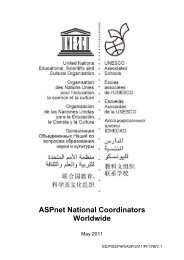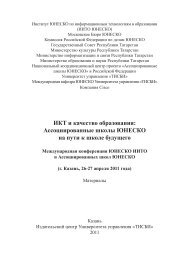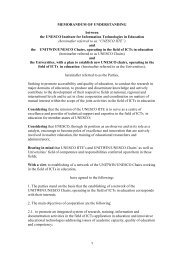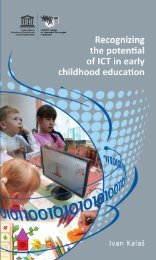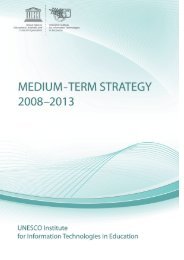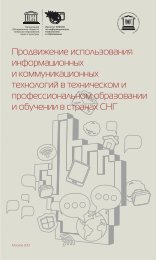UNESCO ICT Competency Framework for Teachers ... - unesco iite
UNESCO ICT Competency Framework for Teachers ... - unesco iite
UNESCO ICT Competency Framework for Teachers ... - unesco iite
Create successful ePaper yourself
Turn your PDF publications into a flip-book with our unique Google optimized e-Paper software.
<strong>UNESCO</strong> <strong>ICT</strong> <strong>Competency</strong> <strong>Framework</strong> <strong>for</strong> <strong>Teachers</strong><br />
12<br />
KNOWLEDGE DEEPENING IN THE EVERYDAY WORK OF A TEACHER<br />
UNDERSTANDING<br />
<strong>ICT</strong> IN EDUCATION<br />
CURRICULUM<br />
AND<br />
ASSESSMENT<br />
A PE (physical education) teacher is frustrated that many of his students are not interested in<br />
physical exercise and do not understand the importance of physical fi tness as part of a healthy<br />
lifestyle. He thinks he can use <strong>ICT</strong> to change their attitudes and help them become fi tter, so<br />
he writes a detailed fi nancial bid to the school administration, explaining in detail why the <strong>ICT</strong><br />
would improve the PE lessons and help students learn.<br />
The PE teacher uses the <strong>ICT</strong> to focus on issues of health which he had not been able to make<br />
vivid and engaging be<strong>for</strong>e. Now he is also able to include in the curriculum in<strong>for</strong>mation about<br />
human physiology. These topics had previously been too abstract and theoretical to explain<br />
easily, but now he is able to show them computer simulations (videos and animations) of the<br />
physiological processes which make them easy to understand. In these ways, the students<br />
achieve a deeper knowledge of PE.<br />
He is also able to carry out <strong>for</strong>mative assessment much more effi ciently because he can now<br />
record students’ per<strong>for</strong>mance in the gym with a digital video camera. He shows these video<br />
recordings to the students to help them understand how to they need to move their limbs<br />
differently. Students who previously could not understand what they were doing wrong in<br />
certain motions can now see instantly what they need to do.<br />
PEDAGOGY Previously, he had only been able to talk to the students about the health benefi ts, which the<br />
students did not fi nd very interesting, but now he is able to show them dramatic clips from<br />
fi lms, sporting events and music and dance videos which feature athletic celebrities and make<br />
fi tness look very attractive.<br />
He then organizes the students into collaborative groups so they can devise their own fi tness<br />
assessments, such as seeing how quickly their heart rates return to normal after exercise.<br />
They analyse their assessments and each student comes up with recommendations <strong>for</strong> a<br />
fi tness program <strong>for</strong> one of the others in the group. They set up a collaborative spreadsheet to<br />
track their progress over the next month. As they go through their fi tness programmes, they<br />
comment and support each other on a social networking site.<br />
ORGANIZATION<br />
AND<br />
ADMINISTRATION<br />
TEACHER<br />
PROFESSIONAL<br />
LEARNING<br />
<strong>ICT</strong> The teacher obtains:<br />
a laptop computer and a data projector so that everyone in the class can see computer<br />
display<br />
video clips from the Internet<br />
PE and human physiology simulations and animations<br />
simple data capture devices such as heart-rate sensors which record data directly to the<br />
computer<br />
spreadsheet software <strong>for</strong> students to record their fi tness assessments each week<br />
a digital video camera to record students’ movements and use of the fi tness equipment in<br />
the gym.<br />
The students also use other computers at school and at home to access the shared spreadsheet<br />
and the social networking site. Some students use their mobile phones to post their daily<br />
fi tness programme achievements on the networking site.<br />
The PE teacher only has his own laptop and a data projector in the gym <strong>for</strong> showing video<br />
material, but by getting the students to help with the videoing in the gym and by playing back<br />
the video clips on both the camera screen and the computer screen he is able to arrange PE<br />
activities in such a way that all the students are able to see a video clip of themselves in the<br />
gym at least once in each lesson or to record the results of their weekly fi tness assessment.<br />
The teacher uses his laptop to monitor the students’ entries on their collaborative<br />
spreadsheet, and to post on the social networking site encouraging comments and extra<br />
in<strong>for</strong>mation on fi tness programmes.<br />
The teacher regularly visits an Internet discussion <strong>for</strong>um hosted by the professional association<br />
<strong>for</strong> PE teachers. The <strong>for</strong>um is a useful source of new ideas on how to get students more<br />
interested in PE and exercise. He, <strong>for</strong> example, posts a question asking <strong>for</strong> technical advice on<br />
an aspect of a new fi tness programme the students want to try out.






